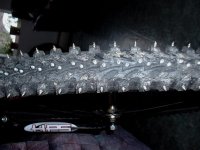lose traction on the rear wheel in a straight line, you would want to cut power to the rear and add power to the front. But do that in a turn, if the rear wheel was slipping sideways, the sudden regaining of traction can cause the bike to flip over, and it's best to let the back wheel keep slipping as long as the angle can be maintained.
Lose traction on the front wheel, and you would want to kill all power to the rear smoothly, as you lose all ability to steer and balance when the front slips. But if you're trying to climb a hill, you might want it to lock the rpm of both wheels and let them slip



